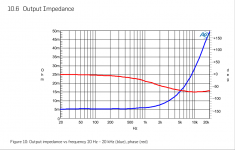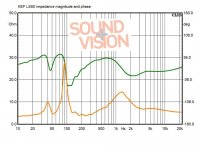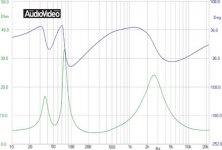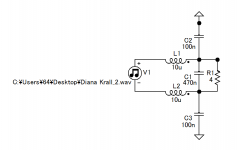Two days ago I was reviewing, again, the manual of the new IcePower 1200AS2 class D module and I was struck by this graph, where the phase shift is almost 70º at 20 kHz!

Hypex NC500 only says:
Is it usual in this type of amplification? Taking into account that the phase also varies -except specific filters- in the speakers, how does it affect sound at high frequencies?
KEF LS50

KEF Q100


Hypex NC500 only says:
Output coil inductance: 10 uH Effective output inductance ithis number divided by loop gain.
Is it usual in this type of amplification? Taking into account that the phase also varies -except specific filters- in the speakers, how does it affect sound at high frequencies?
KEF LS50

KEF Q100

Last edited by a moderator:
I would ask Bang & Olufsen as it is their trade name and design.
I suspect the phase shift makes little difference at Ultra Sonic frequencies, say above 18kHZ as we cannot hear them.
I suspect the phase shift makes little difference at Ultra Sonic frequencies, say above 18kHZ as we cannot hear them.
About - ICEpower
Hi from Spain,
I just open a thread about the phase shift in Icepower 1200 AS2.
http://www.diyaudio.com/forums/clas...ass-amplifiers-affects-sound.html#post5408076
[ Two days ago I was reviewing, again, the manual of the new IcePower 1200AS2 class D module and I was struck by this graph, where the phase shift is almost 70º at 20 kHz!
[URL]http://maty.galeon.com/WP-imagenes/hard/IcePower-1200AS2-output-impedance-phase.png[/URL]
...Taking into account that the phase also varies -except specific filters- in the speakers, how does it affect sound at high frequencies
- maty -
[/QUOTE]
Phase, Time and Distortion in Loudspeakers
http://sound.whsites.net/ptd.htm#s4
http://sound.whsites.net/ptd.htm#s4
4 - Phase Audibility
The audibility of absolute phase is nil.
From Dr Floyd Toole:
"It turns out that, within very generous tolerances, humans are insensitive to phase shifts. Under carefully contrived circumstances, special signals auditioned in anechoic conditions, or through headphones, people have heard slight differences. However, even these limited results have failed to provide clear evidence of a 'preference' for a lack of phase shift. When auditioned in real rooms, these differences disappear ..." [4]
... There have been many tests and experiments to look at phase shifts within the audio band, and whether they are audible. Under controlled laboratory conditions (or using headphones), there is strong evidence that with single (complex) tones, there is an audible change. However, in a listening room with speakers reproducing music, there is little evidence that phase shifts are audible with the vast majority of recorded material...
The second version of the all-pass network gives a completely different waveform, simply because the phase varies from 0° at low frequencies to 180° at high frequencies.
An externally hosted image should be here but it was not working when we last tested it.
Note that this particular class of filter is called 'all pass' - it passes all frequencies equally (i.e. the magnitude is unaffected). Not much of a filter by normal standards, but a useful tool nonetheless. Interestingly, if the input and output of an all pass filter are summed, the result is an ordinary filter. High and low pass responses are available. Not that there is a great deal of point, since this is vastly more complex than a 6 dB/ octave filter built conventionally. I just thought I'd mention it - someone might be interested 🙂
I would like to offer an experiment about audibility the phase lag in highs. We need any DSP with 1st order all-pass filter with F=40kHz(Fs=>96Khz, 20khz will be also about -70deg), and golden ears. I know, I'll not hear the difference.
I’m an old school rocker who destroyed his hearing on stages in pubs and clubs over the decades with a 100 watt Marshall head and a pair of 4x12” cabinets. Adequately powered, quality PAs in these smaller venues were unheard of prior to the mid to late 90s, hence the need for the Marshall flamethrowers. My point is that I need hearing aids in order to hear much anything above 2 kHz. I switched to bass a few years ago and while I’m using a 500 watt Class D amp and a 4x10” cab, because bass freq are more power dependent, I’m not creating the insane sound pressure levels. Also I am a light touch bassist, so all that clean headroom is so that I don’t have to beat my strings like they owed me money. Point being is that I’ve never noticed any unpleasant phase shift artifacts even at 2 kHz where I still can kinda hear naturally. I noticed the article that states the ability of the human ear to adapt. I can attest that I find the proposition to be true.
humans are insensitive to phase shifts
Humans use phase shift to know what direction a sound is coming from.
Relative phase is audible, depending on the amount, the frequency and the context. Two speakers side by side with 90° phase shift between them will sound dreadful - and the sound will change as you move about. The relative phase of two musical instruments playing in harmony makes the sound you hear - take away the phase shifts, and it will sound flat and lifeless.
I've simulated the wave file as source and saved R1 voltage as wave file again. That's typical H-bridge LC filter, suitable for most popular Ti amps. 20kHz -40deg. Anyone hear the difference original vs simulated?
Diana Krall_1.wav — Yandex.Disk
Diana Krall_3.wav — Yandex.Disk
Diana Krall_1.wav — Yandex.Disk
Diana Krall_3.wav — Yandex.Disk
Attachments
Easy. With foobar2000 and JRMC 64 bits.
One sound more "natural" or "credible", with more "body" than other.
One sound more "natural" or "credible", with more "body" than other.
I would like to point out that in the original post the graphs of phase are the electrical phase of the loudspeakers. This has absolutely nothing to do with the acoustic phase shift of the drivers + crossover combination.
I would like to point out that in the original post the graphs of phase are the electrical phase of the loudspeakers.
...
Yes, the second and third are of the magnitude and phase of speaker impedance.
The first is the output impedance and the phase of that output impedance of the "IcePower 1200AS2 class D module".
...This has absolutely nothing to do with the acoustic phase shift of the drivers + crossover combination.
Yes again
Two weeks elapsed from my email to Icepower and there is no answer. 🙁
Phase shift in class D amplifiers. How it affects the sound?
Phase shift in class D amplifiers. How it affects the sound?
Is anyone else encouraged to make the test?
Yes. No audible difference for me.
Thank you for the answer.
It seems that the subject does not interest. The absence of more comments makes me more intrigued by the phase shift in the audio band. Class D technology.
It seems that the subject does not interest. The absence of more comments makes me more intrigued by the phase shift in the audio band. Class D technology.
- Home
- Amplifiers
- Class D
- Phase shift in class D amplifiers. How it affects the sound?
